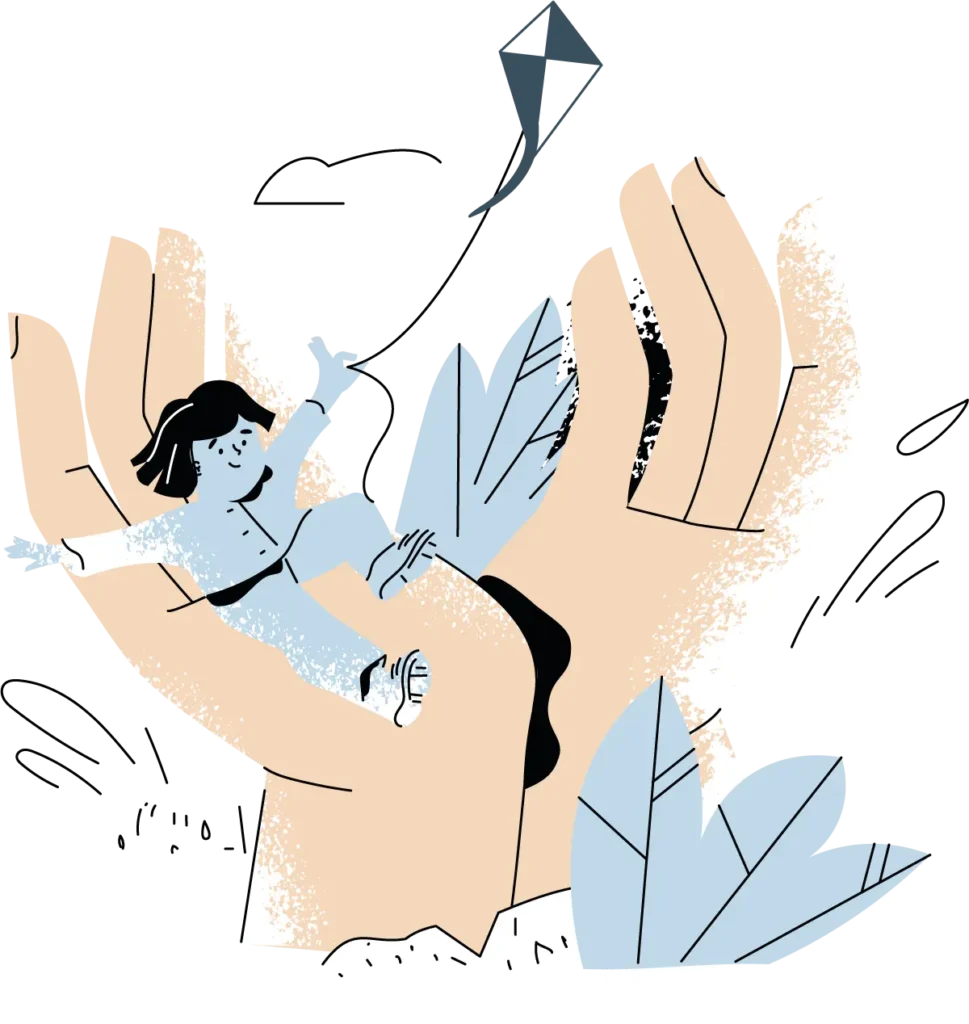What are Behavior Problems in Childhood?
Behavior problems in childhood are failures to follow the rules or follow an adult’s directions.
It is important to note that most children will often misbehave as a part of typical development. Some research indicates that the average child misbehaves every 5-10 minutes.
Child behavior problems can take many different forms. In this article and the related topic articles in this section, we will review the following types of behavior issues in more detail. You will understand when to be concerned and how to support your child in developing more appropriate behavior.
Types of Behavior Problems
- Non-compliance: refusing to follow the rules or listen to instructions
- Rigid behavior: stubborn and inflexible behavior
- Bossy behavior: ordering others around and telling people what to do
- Tantrums: throwing a fit, including yelling, screaming, or breaking things
- Aggression: hurting others, including kicking, hitting, smacking, or biting others
- Toileting accidents: deliberate urination or bowel movements outside the toilet
- Conduct problems: rule-breaking or lawbreaking behaviors
- Insistence on sameness: expecting on the schedule remaining the same every day; becoming very upset when plans are changed or unexpected events happen
Causes of Behavior Problems
If your child is having behavior problems, it is important to look at what is happening both internally and externally. Internal factors are issues that are either related to a skill deficit (attention, comprehension, communication) or a developmental delay or disorder. External factors are issues that come up in the child’s environment that may lead to or inspire poor decision-making or maladaptive behaviors.
Internal Causes of Behavior Problems
- Gifted children often reject direction from authority. They have somewhat of a non-conforming nature. In this case, parents must be more explicit about the rules and the rationale behind each rule. If you are consistent and persistent as a parent, you are doing your job.
- Comprehension problems: Another consideration when your child is not following directions is comprehension. Make sure your child knows what you are asking them to do. Sometimes when parents give a long series of instructions, the child does not comply simply due to confusion or trouble remembering all the steps. If this is an issue, make your instructions short, explicit, and administer them one step at a time.
- Attention issues: A child who struggles with attention, planning, organizing, and impulsivity may be non-compliant with adult requests. Sometimes, children have difficulty focusing long enough. They don’t have enough time to digest the information, control impulses, and plan and organize their time to complete tasks.
- Rigidity can cause some refusals and upset. Sometimes a child may act out due to discomfort with a change in routine.
External Causes of Behavior Problems
In our work over the years, we have seen an interesting pattern with non-compliance in many children. Often, the parents or other caring adults are unintentionally rewarding bad behavior.
Accidental reinforcement
When parents pay a lot of attention to tantrums and negative behavior, they accidentally reinforce it. This pattern happens a lot because poor behaviors tend to be hard to ignore. If a child is screaming or breaking things, it is the parent’s instinct to go over and attend to that child. However, parents are wise to follow this rule instead, “Turn toward the behavior you want to see and turn away from the behavior you don’t want to see.” There are a lot of resources in the articles that follow to manage these issues as they arise.
Goodness of fit
We have seen it many times in our clinical work. An excellent parent simply does not have the best parenting style for a specific child. This pattern can happen when a child needs structure and predictability, and the parent is naturally more spontaneous. Another time this happens is when a parent is overly strict, and the child is very rigid. In this case, both parent and child are digging in their heels, and bad behaviors prevail.
Causes Of New Behavior Problems
For some children, these bad behaviors are new. These new behaviors can happen when a child has already been in intervention or therapy. It may be that the child is on a behavior plan at school that seems to be working well. Maybe the child has been on that plan for several months and is ticking along just fine. Suddenly, they just stop doing the good behaviors they were doing before.
What is happening?
Intervention Stopped
Usually, the child has either become tired of the reinforcement you have in place, OR, the adults stopped doing the intervention altogether. We have often found that once kids start to make progress, the adults stop doing all of the things that brought that change into effect.
In either case, talk with the child. You can start to learn if new rewards or reinforcement are needed. A new goal could be developed. Or, you simply need to put that good intervention, you accidentally stopped, back into place.
Pulling Away
As kids develop, you may notice a period where they are really “doing their own thing.” Often, this change is just a part of normal development in the early teen years. You may remember your grandma telling you, “enjoy all those cuddles now because one day they won’t want them anymore.”
Yes! This behavior is normal.
The time to be concerned is when your child refuses to socialize with anyone, including peers. This change could signify that your child is depressed or delayed in social development. In that case, seek help from a mental health provider.
But… what if our child is acting quirky, and it’s none of these!?
Ah, Kids!
If your child is just acting quirky, taking time alone, getting obsessed over a specific activity, or telling ridiculous long stories that seem to have no point, this is very likely just fine.
With any “new” behavior, just keep an eye and make sure it isn’t getting in the way of the child’s life AND it isn’t going on for more than a few months. Otherwise, that behavior could be a concern.
What to Do About Behavior Problems
If you are concerned about your child’s behavior or disobedience, take these few steps.
DO keep interactions positive: First, make interactions with your child as pleasant and positive as possible. Only give an instruction you are prepared to enforce. Don’t ask if you are tired and don’t feel like a battle. Provide directions or instructions that your child is likely to follow.
DO give simple directions: As you increase the expectations, break things into manageable steps, one at a time, such as saying, “please get the sheets out of the drier” rather than, “fold the laundry and put it away.”
DO reward good behavior: Provide motivating rewards for the completion of tasks. Play a game as a family, have ice cream, earn a weekly trip to a dollar store, thrift shop, or shop the dollar bin at your local grocery store. If your child does not comply, do not provide the reward. However, make sure there are other times to try to earn rewards. Keep your focus on the behaviors you want to see. The focus on the good things will increase the frequency of positive behavior and your child’s self-esteem.
DON’T reward a tantrum: If a tantrum ensues, stay close by, remove attention, and wait to see a behavior you like. Model calm behavior and avoid any arguments when your child is upset. Stay firm, calm, and consistent.
DON’T focus on bad behavior alone: No matter what happens, always have some fun, relaxed, noncritical time together each day, even if this time is just 10 minutes to read a book.
When to Seek Help for Aggressive Behaviors
First, identify if any of these signs are happening frequently (every day or several times per week).
- Refusing: Not doing what you say or breaking rules
- Deifying authority: Acts rude, breaks items, disobeys, or runs away
- Not following directions: Forgetting or not following directions
- Not listening: Saying, “I didn’t hear you.”
- Avoiding tasks: Making excuses for not getting things done
- Not doing chores: Appearing unable to follow through with tasks you assign
- Angry attitude: Huffing and puffing around when asked to do a small chore
- Disobeying authority figures: Not listening to the teacher or other adult
- Aggression: Hitting, kicking or hurting others
If any of the above are happening, a concern may be present. The most important behavior to look for is aggression. In the big picture, regardless of the cause, aggressive behavior will not be a tolerable way to interact with peers in school or in the community. As a parent, you can look at the guide below to know how to intervene with aggressive behaviors at various ages.
Aggression in toddlers & preschoolers: Sometimes, toddlers and preschoolers may display aggressive behaviors. Kids under four are often inclined to express their needs physically before they get the words down to express their needs verbally. This behavior is only a significant issue if the child is aggressive frequently, tantrums almost daily, or seems to be making slow progress in expressing wants and needs. In this case, early intervention services can be beneficial to support your child and family.
Aggression in kindergarten kids: By kindergarten, we want to see aggression dropping off dramatically. An occasional ‘aggressive’ act might happen, but regularly using punching or kicking to communicate will not be tolerated at school. If your child is showing lots of aggressive behaviors, or school problems, talk to the school psychologist or counselor, or reach out to a psychologist in the community.
Aggression in school-aged kids: By mid-elementary, the frequent or sudden onset of aggression is a concern. If your child is very angry or physically aggressive, something could be going on emotionally. Think about whether or not your child has experienced a recently upsetting experience, such as a move, death of a loved one, or divorce. If so, the child is at increased risk for behavior problems and may need therapy or support to get through that. If not, your child may have another emotional or behavioral issue. Either way, seek out the help of a school psychologist or a psychologist in the community.
Aggression in teenagers and adolescents: By middle school or high school, any aggression or violence is cause for concern at this age. You will want to dig in to understand what is going on with your child. If there are significant communication skill challenges, they will sometimes use aggression to deal with frustration. Often depression or another mental health condition may appear as irritability or aggression. If a child or teen experienced trauma, there is an increased risk for aggression and significant behavior problems. Seek help from a mental health provider right away.
Further Resources on Behavior Problems
If the behavior is causing concern in your family, the important thing to think about is, “does this behavior appear to be in my child’s control or not?”
Your child’s behavior may be purposeful as a means to get what they want. It is normal for kids to attempt to control their environments. However, as parents, it is our job to teach our kids to get their needs met with appropriate behavior. If your child or your family feels chaotic, you may need more help. Sometimes there is an imbalance of control or authority that needs to be corrected. It may be that the child’s behavior has become a bit entrenched and is causing a lot of distress for everyone involved. It could be time to reboot and get a consultation with a professional.
Below is a list of types of providers that can help you with a more significant behavior problem. Often, when a behavior plan is needed, parents need support from a professional. Once parents design and implement a behavior plan with a therapist, they are often able to maintain it on their own. If your child’s behavior is wreaking havoc, you may need help and that help will depend on your child’s skills and needs.
- Psychotherapist or play therapist: to treat emotional symptoms and help with social skills training, planning, and organization
- ABA therapist: to treat behavior; or to conduct an analytical Functional Analysis of the behavior that can help guide treatment
- Psychologist or neuropsychologist: to consider a full assessment to look at symptoms in mental health or behavioral context
- Child or adolescent psychiatrist: to prescribe and manage psychotropic medication for inattention or impulsivity challenges that may be impacting behavior
- Family therapy: to understand behavior challenges in context. All behavior occurs within a specific environment. If possible, family systems therapy is an excellent way to address a child’s behavior within the context of the family.
Resources for Behavior Problems
Barkley, Russell A. (2013). Taking charge of ADHD, 3rd edition: The complete, authoritative guide for parents.
Durand, V. Mark & Hieneman, Meme (2008). Helping Parents with Challenging Children Positive Family Intervention Facilitator Guide (Programs That Work).
Greene, Ross W. (2001). The explosive child: A new approach for understanding and parenting easily frustrated, chronically inflexible children.
Kroncke, Willard, & Huckabee (2016). Assessment of autism spectrum disorder: Critical issues in clinical forensic and school settings. Springer, San Francisco.
Purvis, Karyn B., & Cross, David R., & Sunshine, Wendy Lyons (2007). The connected child: Bring hope and healing to your adoptive family.
Seigel, Daniel J. & Bryson, Tina Payne (2014). No drama-discipline: The whole-brain way to calm the chaos and nurture your child’s developing mind.


